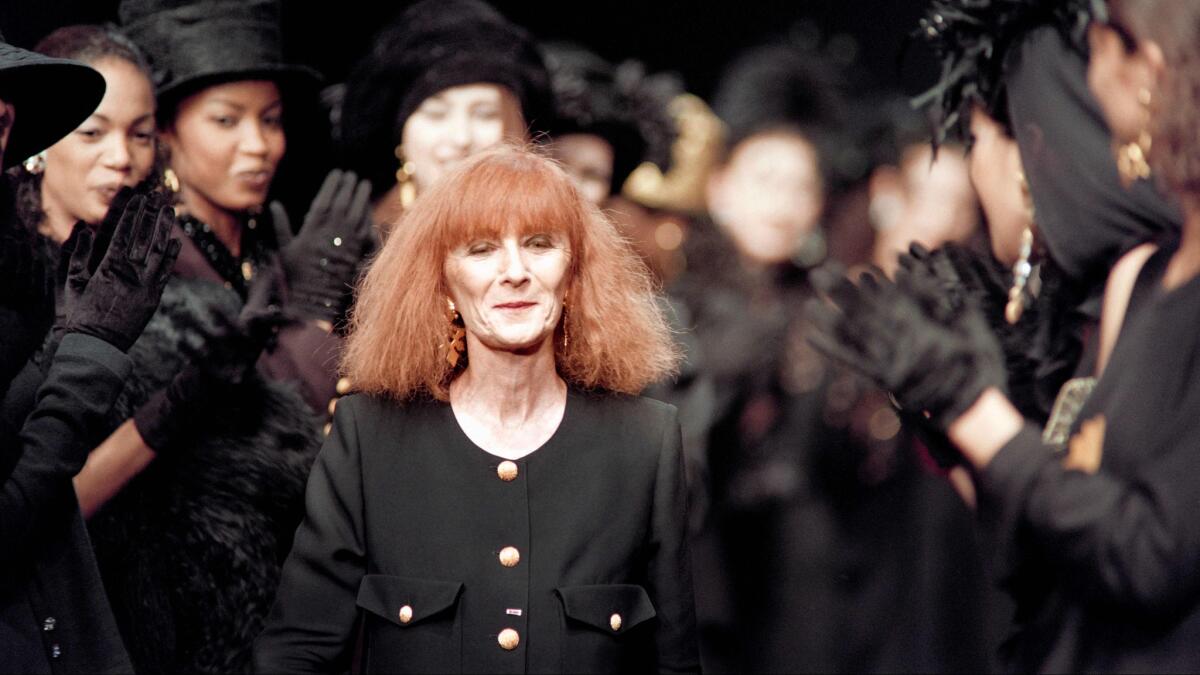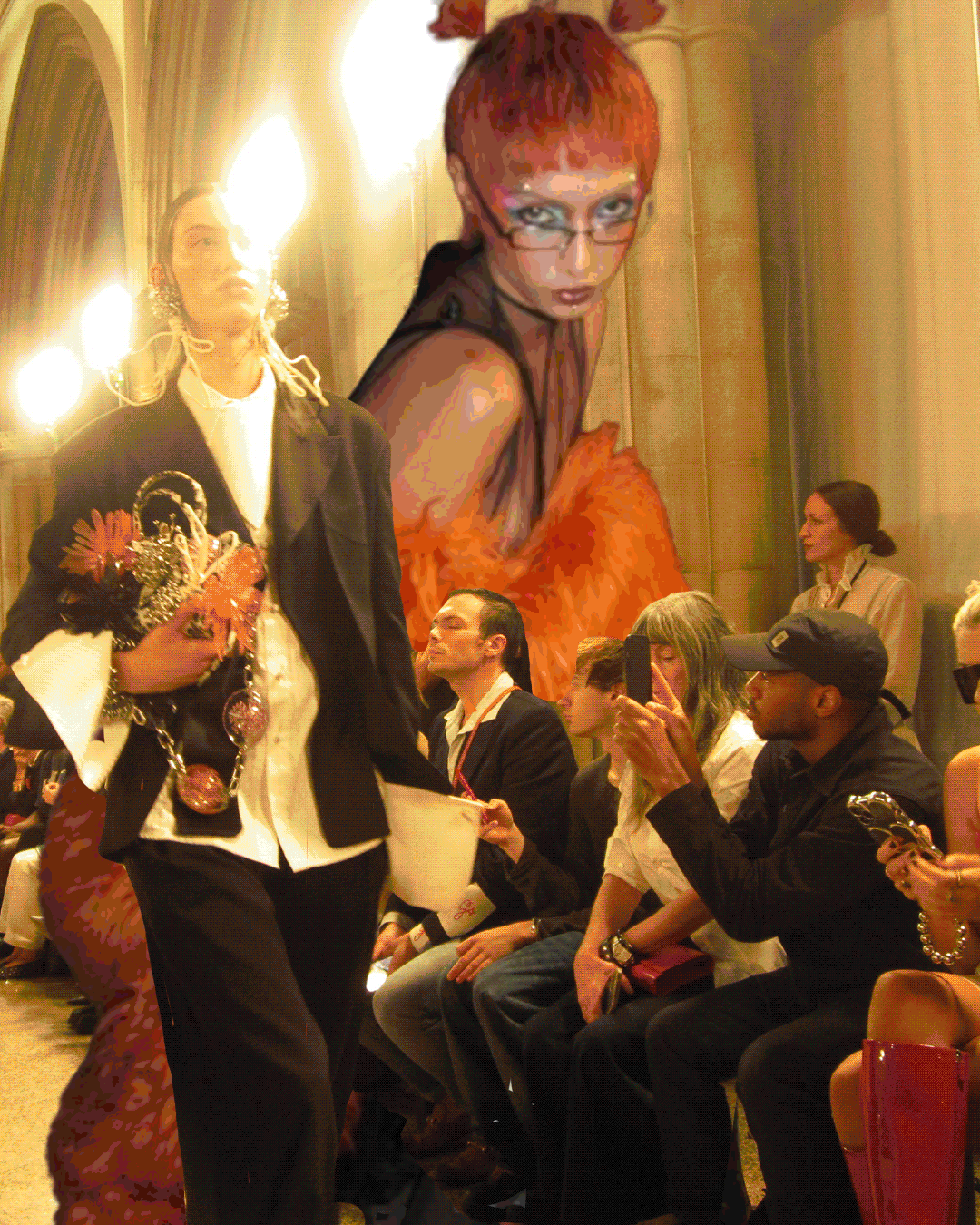Sonia Rykiel, the French fashion designer called ‘the queen of knitwear,’ dies at 86

- Share via
Sonia Rykiel, a beloved French designer synonymous with striped sweaters and Left Bank insouciance, died Thursday in Paris after years living with Parkinson’s disease and osteoporosis. She was 86.
Jean-Marc Loubier, president and chief executive of First Heritage Brands, the holding company for Sonia Rykiel and Delvaux, confirmed her death to WWD.
He called her a fashion “pioneer” who considered her designs aids to liberate and empower women as they gained fuller participation in society.
A sign of her zesty personality, she did not consider pants a way for women to be equal with men but to afford equality to women who might not have beautiful legs, he noted.
“She had this tremendous seduction: Her eyes, voice, attitudes, words,” said Christian Lacroix. “She epitomizes a certain brand of ‘French-ness’ and Paris since the Sixties — free and elegant girls, with French style, French attitude and French freedom, both erotic and intellectual.
“She was the link in between Vionnet, Schiaparelli, Chanel and her generation of women designers, with a modern, feminist, optimistic and free approach to fashion, the world and the times.”
Lacroix associates her name with “a very precise, sinuous silhouette, knitwear forever, stripes, sequins, fedoras, Twenties makeup, black and beige.”
“Sonia Rykiel was a revolutionary designer. I have great admiration for the work that she has done on liberating women and their fashion. And she gave the inspiration and the style to all of us,” Jean Paul Gaultier told WWD.
Rykiel had long since passed the design reins to a series of young designers. Julie de Libran, an alum of Louis Vuitton and Miu Miu, is the current creative director.
Famous for her triangle of red hair and saucy personality, Rykiel won fans with her feminine, witty sweaters, often striped, sequined or imprinted with words — though she never learned to knit herself.
Born in the Paris suburb of Neuilly, the eldest of five daughters of a Russian mother and a Romanian father, Rykiel, nee Flis, never aspired to be a designer.
“I was supposed to be a mother like my mother, who didn’t work,” she said. “My husband [Sam Rykiel, whom she married in 1953] had a boutique called Laura.”
When she became pregnant, “I wanted a maternity dress, but I couldn’t find anything I liked. Everything was abominable. So I made one. Then I made a pullover. Elle put it on the cover. Then WWD elected me the Queen of Knitwear.”
Her shrunken 1962 “poor-boy” sweater, with its fine ribbing, which she prevailed upon the Laura knitters in Italy to make, became a landmark design of the early Sixties.
A Laura boutique opened in Galeries Lafayette in 1964. Rykiel, who had her daughter Nathalie in 1956 and her son Jean-Philippe in 1961, divorced her husband in 1968 and opened her first self-named shop in May of that year on the Rue de Grenelle in the heart of the arty Saint-Germain-des-Prés area.
The neighborhood, rocked by student protests at the time, was right for a designer like her — although she had to close her shop the day after she first opened it because of unrest in the streets. Success came quickly, and her business grew. In 1969, she opened an in-store shop at Galeries Lafayette, and her clothes were picked up by Bloomingdale’s and Henri Bendel in New York.
Looking back on those years for WWD in 2008, Rykiel said, “Since I didn’t know anything, I did everything I wanted. I didn’t listen to anyone. I was so violent, so authoritarian, only listening to what I wanted and myself. People loved me or hated me. Those who loved me, loved me a lot. The others, I didn’t bother with them very much.”
Rykiel kept the company in the family, one of the last French houses to remain that way, until 80 percent of it was purchased by Fung Brands — a luxury company owned by two Hong Kong billionaires, Victor Fung and William Fung, and headed by Loubier — in February 2012. The family retained a 20 percent stake.
Nathalie Rykiel, who had begun working at the house by modeling for it in 1975, became its managing and artistic director in 1995, its creative director the next year, and expanded the fashion house into children’s wear, a diffusion line now called Sonia by Sonia Rykiel and introduced shoes and accessories. The Rykiel Homme collection, first designed by Tomas Maier, was produced from 1990 to 2009.
Sonia Rykiel was also known for her long, slim shapes, often in jersey; knits that were either cropped or oversized, and fur chubby jackets in shades such as bright pink and blue. Red, white and black were important elements in her signature palette.
In 2002, the company tried something new by launching Rykiel Woman, a lingerie and erotica shop on the Rue de Grenelle, which sold sex toys. Nathalie Rykiel said of this, “It worked out, because my mother strove to liberate women. [Forty] years ago, she told them to ditch their bras under her little poor-boy sweaters. She told them to embrace liberty. Now we are being provocative in another way.” Nathalie did a clothing collection for La Redoute in 1995 and a lingerie line for H&M in 2009, with an accessories and knitwear collection for that firm launched the next year.
For Sonia Rykiel, in fact, being provocative was as important as the sweaters that became her trademarks. Her first slogan sweater in 1971 broadcast “Sensuous,” a term that WWD had used to describe her and. It became a bestseller. She often spoke of the importance of lovers in a woman’s life.
Rykiel created clothes that were unpretentious and woman-friendly at a time when French feminism was being revived by the youthful rebellion of 1968. Her Seventies heyday reflected the freedom in the fashion air; her styles were most commonly described as eccentric, whimsical and oh-so-French. “Nineteen-sixty-eight was the beginning of the hippie movement in fashion,” she told W magazine in 1997. “That movement made fashion change completely. It was not necessary to be always dressed up. You could be dressed the way you wanted — it was absolute freedom.”
She went on to state matter-of-factly, “I invented everything in the Seventies. Sweaters without shoulders; quilted jackets; showing inside seams outside.”
Regarding the unchanging nature of some of her designs, she quoted Jean Cocteau, who said that “he always made the same portrait. The trick is to last, and to last while not always doing the same thing, but not doing something entirely different. It’s important in fashion to stay who you are, but to always be in the mood and the air du temps [italics].”
Rykiel believed women should define their own fashion, not the other way around. In the late Seventies, in fact, she began to say that fashion itself was “demode,” and in 1978 she showed a collection which mixed her clothes with those of other designers on the runway, the way they’re worn in real life. She expressed these views in her first of her many books, which were often done with photographer Dominique Issermann, a novel in diary form, “Et Je la Voudrais Nue” [“And I Would Like Her Nude”] in 1979.
She published an erotic novel, “The Red Lips,” in 1996. She said it was about a “love triangle between a man, a woman and a sweater.” In describing her early design process, she said, “I made clothes spontaneously. When it rained, for example, I designed a trenchcoat. When it was cold, I did a coat. I followed my instincts.”
Rykiel also had a hand in decorating some of Paris’s most luxurious hotels. She was asked to help revamp the interior design of the Hotel de Crillon in 1982, and she worked on the redesign of the Hotel Lutetia and its brasserie in 1985. Andy Warhol painted his four famous portraits of the designer that year.
In 1994, Rykiel was even featured in Malcolm McLaren’s album “Paris,” singing in a song called “Who the Hell is Sonia Rykiel?” Robert Altman was inspired to make his 1994 film “Pret-a-Porter” after he and his wife attended a Rykiel fashion show.
Rykiel had seen a great deal of change during her years in fashion. The metier, she told WWD in 2008, is “completely different to when I started. Fashion today is another story. Today I don’t invent in the same way. We don’t live in the same way. With all of the computers, it has changed the way we design and cut. It’s incredible. Before I went to the factory…we did everything manually. The computer does everything today. Also, fashion isn’t sold in the same way. There are the big groups. There are very few people like us, outside of the machine.”
To commemorate the firm’s 40th anniversary in 2008, Nathalie Rykiel threw a party in her mother’s honor, which included the designer’s latest collection and, as a surprise, she asked a group of designers, including Martin Margiela and Ann Demeulmeester to create dresses in homage to the Rykiel style. The designer also put on a retrospective at the Musée des Arts Decoratifs in 2008 which featured about 200 outfits and showed not only her fashion but illustrated her role as an inspiration to her peers.
Olivier Saillard, the curator of the exhibition, said, “Rykiel did minimalism before the Japanese and turned clothes inside-out before the Belgians.” He added, “There was a sense of permanence to her work. When you look at older pieces alongside the more recent, the older ones aren’t out of fashion.”
In 2007, Nathalie Rykiel became president of the company, and Sonia Rykiel appointed Gabrielle Greiss as its new creative director. Rykiel noted in an interview with WWD, “I worked alone for 35 years. And now, for the last five years, I’ve started working with a team. It was a decision. I knew I needed to accept that if the name was to exist in time.” Greiss held the job for a year. Subsequent creative directors included April Crichton and Geraldo da Conceicao.
In 2009, Rykiel was given the Légion d’Honneur by French President Nicolas Sarkozy. Sarkozy praised Rykiel in a speech before making her a commander of the order. (She had been named an officer of the French Ordre des Artists et des Lettres in 1993 and an officer of the Legion d’Honneur in 1996.)
“You are terribly French,” he said of Rykiel. “We need more free spirits like yours to turn our habits on their heads. Our country is too conservative; you contributed to French elegance.”
In addition to expanding her namesake brand, Rykiel dabbled in acting and designed costumes for plays. She was also an inspiration for many artists’ exhibitions and books.
In 2009, Rykiel designed a plastic belt that was purchased by First Lady Michelle Obama. The designer said, “[Everyone at the fashion house] is happy when Madonna wears one of my dresses,” but added that she herself was more excited that someone like Michelle Obama is a fan. “I find her fascinating: a very strong woman and a huge asset to her husband,” she said.
Of her decades-spanning career, Rykiel said, “I think there is a future for a house like ours with a way of acting that’s different. I love this métier. It’s what makes me happiest.”
WWD’s Ryan Stevens contributed to this report.
ALSO
French burkini ban puzzles, upsets Muslim fashion designers
Paris Fashion Week: Sonia Rykiel back on the map
Fashion industry remembers Bill Cunningham







